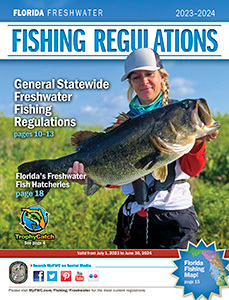Advisories
Florida’s freshwater fish—fun to catch, good to eat & healthy too!
Why eat fish?
Eating fish may help reduce your risk of heart attack and stroke. Fish high in omega 3 fatty acids—a type of fatty acid that supports fetal, infant and child brain and eye development—are good for mothers and children.
How much should I eat?
Adults should eat about 8 ounces of fish each week, and women who are pregnant, or breastfeeding, should eat 8 to 12 ounces (cooked weight) of fish per week. Eating a variety of fish has the most benefit.
What about mercury exposure?
For most people, the risk of eating mercury-exposed fish is not a health concern, but developing fetuses and young children are more sensitive to the effects mercury has on the brain. Women of childbearing age and young children should eat fish with low mercury levels. Mercury can’t be cut away, cleaned or cooked out of fish.
Basic Guidelines for Eating Freshwater Fish |
||||
The following Basic Eating Guidelines provide general advice to anglers from all untested fresh waters in the state. For more detailed guidance for all fresh waters, consult the Florida Department of Health publication Basic Guidelines for Eating Freshwater Fish |
||||
Eat up to a maximum of 2 meals per week of these fish with very low mercury: (1 meal is 8 oz. uncooked, or 6 oz. cooked) |

|
|||
Eat up to a maximum of 1 meal per week of these fish with very low mercury: |

|
|||
Eat up to a maximum of 1 meal per month of these fish with low mercury: |
|
|
|
|
Black bass including largemouth bass: Bass smaller than 16 inches. If in one month you eat a meal of the fish listed above: Don’t eat any more fish listed as eat 1 meal per month. Instead eat only other high omega-3, low-mercury fish for the remainder of the month, try: farm raised rainbow trout, salmon, farm raised catfish and mullet. |
||||
Do NOT eat: |
Black bass including largemouth bass larger than 16 inches. Avoid eating bowfin and gar. |
|||
Eat up to a maximum of 2 meals per week of these fish with very low mercury: (1 meal is 8 oz. uncooked, or 6 oz. cooked) |

|
|||
|
|
|
||
Eat up to a maximum of 1 meal per week of these fish with low mercury: |
|
|
||
Eat up to a maximum of 1 meal per month of these fish with moderate mercury: |
|
|||
Black bass including largemouth bass: Bass of any size. If in one month you eat a meal of the fish listed above: Don’t eat any more fish listed as eat 1 meal per month. Instead eat only other high omega-3, low-mercury fish for the remainder of the month, try: farm raised rainbow trout, salmon, farm raised catfish and mullet. |
||||

